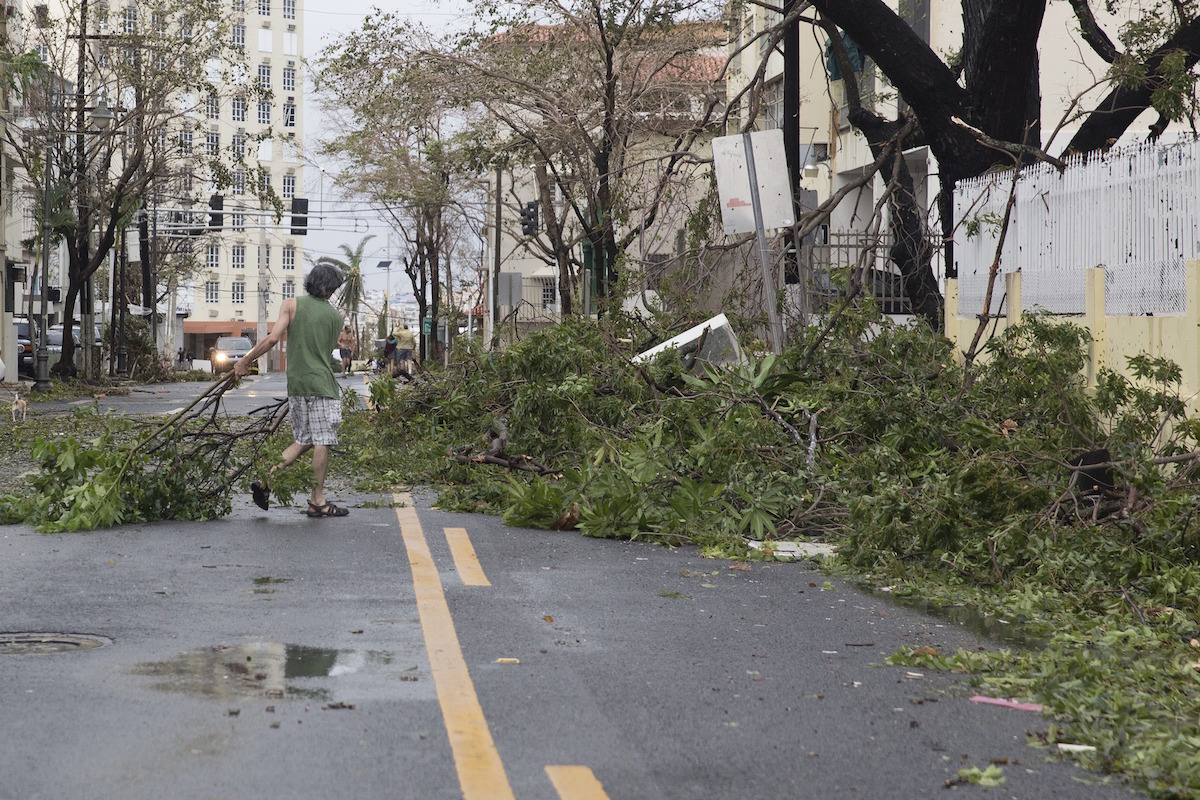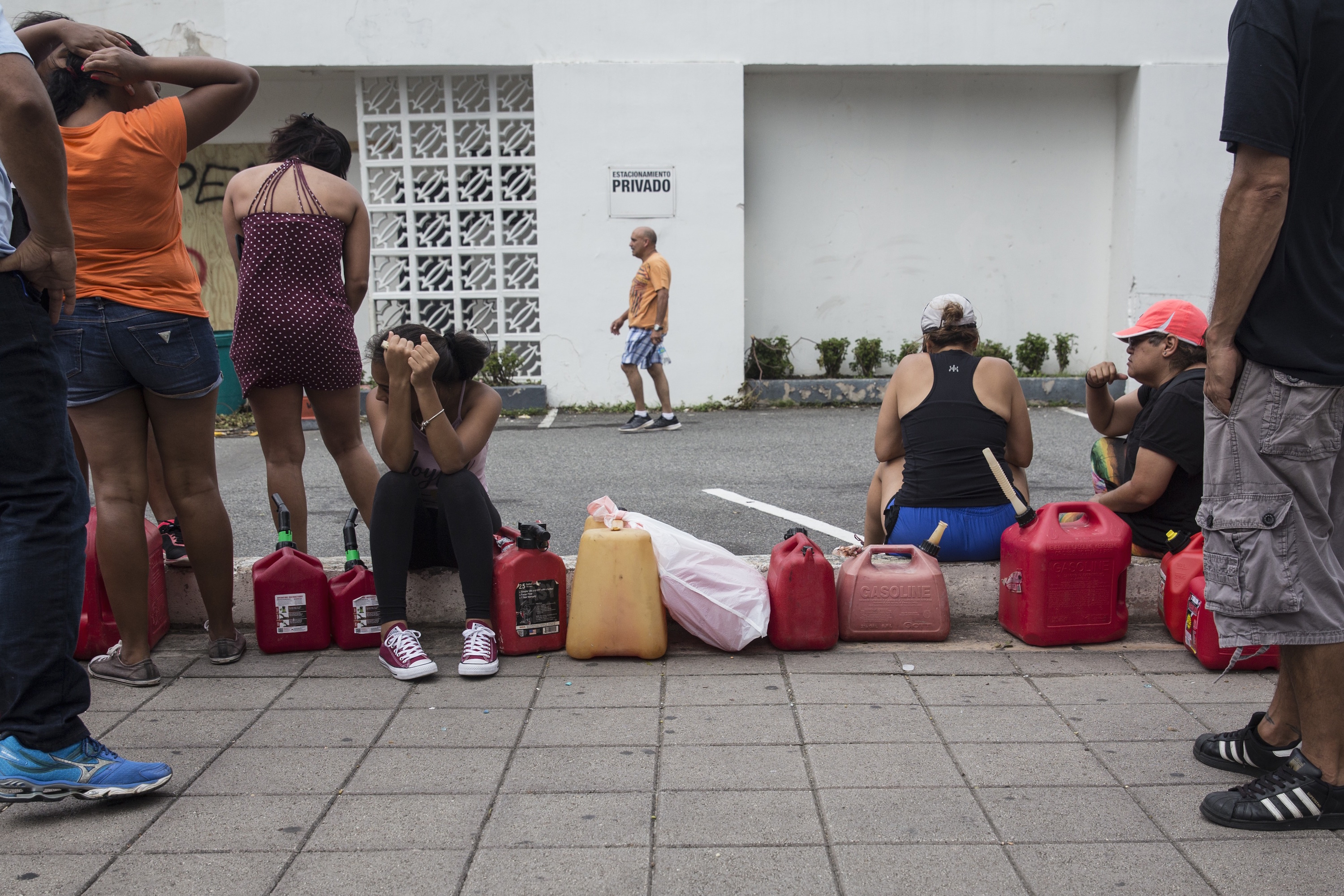For Puerto Ricans, the devastation wrought by Hurricane María created a time divide – life before the storm and life after. But today, on the first anniversary of the storm, there’s still much unaccounted for in understanding why the subsequent crisis unfolded as tragically as it did. The inadequacy of federal aid certainly played a major role in the humanitarian crisis, but there is another variable in question: Had Puerto Rico not been saddled with debt when Hurricane María hit, could some of the estimated 2,975 deaths post-storm have been prevented?
In the days, weeks, and months after September 20, people died because of a lack of medical treatment – oxygen tanks, dialysis treatment, insulin, and life-sustaining medications all became inaccessible without electricity in homes and hospitals. The widespread blackout came as a result of a neglected power grid.
But the emergency response plan at the island’s Department of Health had been neglected, too: it was outdated, designed with storms no stronger than Category 1 in mind. The public healthcare system was also in shambles, and other parts of infrastructure, like roads and bridges, hadn’t been well maintained. That Puerto Rico’s cash-strapped government couldn’t manage upkeep of public services throughout some 10 years of recession – in which it amassed $120 billion in debt and pension liabilities, prompting the passing of the US law PROMESA and the implementation of a federally appointed Fiscal Oversight Board – goes without saying.

But how did Puerto Rico’s economy come to this? With the austerity measures – cuts to pensions, budget reductions and tuition hikes to the public university system, anti-worker labor reforms, and public school closures – enacted in the past by the Puerto Rican government or insisted upon more recently by the Oversight Board (known as La Junta) under PROMESA, we know who pays the price: The people of Puerto Rico. What we don’t know, however, is who exactly is responsible for this debt – not with total transparency, at least. That’s why Frente Ciudadano por la Auditoría de la Deuda is mobilizing Puerto Ricans to realize a comprehensive audit of that debt.
Using a method of auditing that combines several approaches, the citizen-led nonprofit will examine financial activity of the island’s government throughout the past 40 years.
“There is a lot of information that they are probably afraid of getting out.”
Eva Prados Rodríguez, a lawyer working among the island’s human rights and feminists movements, is a member of the Frente’s commission of 17 people, who represent a breadth of sectors and interests: Pensioners, unions, cooperatives, public education, finance, business, public health, environment, agriculture, and public housing, among others.
Because the Puerto Rican constitution sets limits on how it can accrue public debt and for what purposes, Rodríguez explains, “More than half of the debt issued by the government of Puerto Rico could be in violation of its constitution.”
The Frente’s audit will not only address the evolution of that debt, including when the government borrowed the money and why, but will also identify the people involved – both borrowers and lenders.
“There are politicians and figures that have relationship with those financial entities that fund political campaigns, government projects. You have people in both parties involved with these institutions,” she says. “There is also a lot of corruption – a lot of inside decisions that I’m sure were poor ones, and that information, obviously, is going to bring to light corruption and misuse of funds. There is a lot of information that they are probably afraid of getting out.”
In August, the Fiscal Oversight Board produced an analysis of Puerto Rico’s debt. Commissioned last year, the resulting 600-page report from the law firm Kobre & Kim mainly details how the debt was accrued: Puerto Rico’s Sales Tax Financing Corporation (COFINA) was used to leverage higher credit ratings and accrue more debt; bond issuances paid short-term loans for PREPA, the island’s power authority; and it pointed to rating agencies for “undeserved high ratings that made bonds more attractive to certain investors.” The report questioned where the Puerto Rico Water and Sewer Authority spent some money borrowed through bonds, but didn’t offer a full explanation.
For the Frente, that report didn’t answer the necessary questions about the legality of the debt. It certainly wasn’t worth its price tag of $16 million, paid for by the Puerto Rican government – essentially, the Puerto Rican people.
That report did, however, carry a reminder of the burden US colonialism places on the island. It named disparities caused by the Possession Tax Credit, which gave concessions to US companies for establishing businesses on the island. The law was eliminated in 1996 and grandfathered out through a period of 10 years, but has since been basically replaced by similar tax incentives for outside companies – and all of those laws encourage the establishing of high-income businesses that aren’t labor intensive and, even if they are, set no requirements for minimum local employees or standards of pay (page 475). The report states that it is “not surprising” that “the Possession Tax Credit conferred enormous tax savings on certain companies” but afforded “few clear benefits for local residents.”
The Frente is by no means alone in pushing for a comprehensive debt audit. In fact, Puerto Rico’s own government once began the process of auditing the debt through a 2015 law, Ley 27, that ordered the creation of a commission of public and private sector members to audit the debt issuance from 1970 onward – but that never happened.
“There were unions and different groups stressing the importance of conducting an audit of the debt before beginning any kind of restructuring processes,” Rodríguez recalls. “But the government, under both Alejandro García Padilla and Ricardo Rosselló, have been avoiding conducting these audits.”
Despite García Padilla’s delay in appointing commission members and the withholding of its funding, the commission produced two reports – which Rodríguez says point to the likelihood of constitutional violations in the issuance of the debt – before current Governor Ricardo Rosselló ultimately eliminated the commission altogether last year.
The Frente originally formed back in 2016 to keep that from happening. “We knew that the commission wasn’t being supported by the government,” Rodríguez says. “We knew that if we didn’t mobilize the citizens to demand support for the commission, then the commission could be dissolved at any moment without finishing what it was created to do. It didn’t have the resources; it didn’t have government support.”
Some of the members of the Frente’s commission were part of the original government initiative, but none have government ties. They’ve continued the work since – and they’re not alone in questioning the debt. Puerto Rico’s Center for Investigative Journalism has long been on board, as have the island’s political resistance groups.
During the 2017 student strike at the University of Puerto Rico’s flagship campus in Río Piedras, during which all operations were shut down from February into early June, an audit of the debt was among their conditions. That’s how Eduardo Figarella came to join the Frente as its University of Puerto Rico representative.
Throughout the strike, he says, he drew inspiration from a group that lugged a blackboard around to different camps to illustrate the significance of the debt. “I’m finishing my master’s in public administration with an emphasis on public finance, so it’s a natural fit for me,” he says. “It’s one of my motivating factors to start studying – to be able to deal with the public debt crisis that we’re in.”
The University has suffered budget cuts and tuition hikes as a result of austerity measures implemented to repay the debt. The Fiscal Control Board, Figarella believes, aims to restructure the University of Puerto Rico around a U.S. model, where competition with private institutions affects tuition rates and about 70 percent of students graduate with an average of more than $37k in loan debt.
“I almost have a master’s, and I work for $8 an hour, and I’m lucky.”
When tuition tripled at the University of Puerto Rico this semester, Pell Grants weren’t enough to cover the cost, Figarella says.
“What do we say to the person that maybe comes from a working-poor family and goes to the University of Puerto Rico to have a better chance at basically life?” he asks. “And with the current economic prospects, there’s not much jobs. I almost have a master’s, and I work for $8 an hour, and I’m lucky.”
Puerto Rico’s student loan default rate, as it stands, is higher than most US states. Its poverty rate is more than 40 percent.
“I know a number of people had to stop studying because it’s too expensive. I know people who have had to say I can’t live [near campus] anymore, that they need to commute because it’s too expensive – and we’re talking about tiny $200, $300 studio apartments,” he says.
People are angry, Figarella stresses. The hikes imposed by the Fiscal Control Board, he notes, are a direct result of the debt.
“That the Puerto Rican people did not incur, and that the Puerto Rican people should not be able to be held accountable for,” he says. “But the people have to cope with this in the worst way, which is paying with the A-word: Austerity. And once you get into the austerity cycle, you don’t get out.”
The debt has “been an excuse to implement an economic model that’s negative for the citizen,” Rodríguez adds. “One that seeks to reduce government, one that doesn’t believe in public education, that doesn’t believe in government supporting citizens, where privatization of education, the health system is promoted. They’re going to use the debt as justification to not provide affordable housing for low-income people.”

Can Puerto Rico really progress – from the post-storm after and into a better future – without addressing the real causes of the debt? If the the parties involved aren’t held accountable, how can future transparency be demanded? What guarantees are in place to ensure the same mistakes won’t be repeated? And what about the people suffering – right now – because of the austerity measures already underway?
“One of the things you can see as a result of María is a government structure that’s very deteriorated. That’s why María had the impact it had on the island,” Rodríguez says. “Because the government was paying the debt using public funds instead of maintaining an adequate services in health, education, infrastructure. They were further indebting us, privatizing services, and what was left was a very weak system to respond to a catastrophe. We see a very direct relationship between the debt and the María crisis.”
So far, the Frente has raised more than $29k – but that’s still a long ways from its goal of $500k. It’s just in the first of a six-phase process. Access to information has been a struggle throughout – the Frente suit against the island’s government for access to public records and government correspondence is ongoing.
“The timeline depends on the public. I will be frank with you,” Figarella says. “It depends on how much money we can get and how quickly we can get this money. We think that within a year or less we can get these funds to start doing the most important parts of the debt audit.”







